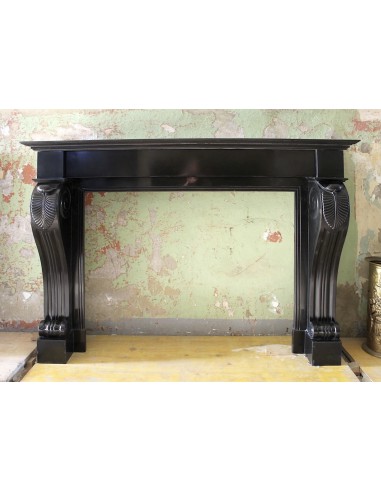I believe that in order to fully understand this fireplace, to be able to fully comprehend its Strength and Grace (two characteristics that can only coexist in works of high art), it is necessary to know its history as well.
That is why I am now going to bore you with a lecture on Art History so long that not even the national Vittorio Sgarbi could offer you, but what can you do, my wife says that in my comments I am logorrhoeic and presumptuous (and maybe she is right, I can't stand as a judge of myself, can I?) while I, on the other hand, think that if I didn't express all that is within my knowledge (however little that is) about the fireplace I am presenting, I would be at fault with the reader and possible buyer of this important art object.
It comes from afar, the architecture of this mantel, even from the 16th century, and it was born in Florence, the cradle of the Renaissance itself, it was born in the villas of the Medici and the notables of the time. I am including a very representative image of a “Renaissance fireplace” among those of the fireplace I am presenting, so you will better understand what I am writing..
Almost always its feet were leonine (to signify and exalt the Strength of its owners) and its legs, as they rose, changed into corbels (called at the time “modiglioni”), corbels often decorated with sculptures of acanthus leaves, corbels that in turn supported the pediment, on which, usually, in addition to some more or less classical decoration, might appear Latin inscriptions with names and dates or coats of arms and/or various blazons.
Over time, this architecture (let's call it “Renaissance”) was well liked, it became, in short an “evergreen” stylism, perhaps decreasing the chimneys in volume (not everyone owned Medici villas..) and also in decorations (real sculptors cost a lot even then, so one was content with the stonemasons under the house), until...
.. .until the French stylists arrived (we are in the early nineteenth century), the Parisian “Ateliers des Arts” in the lead and, just as it had happened in the past and just as it will happen again in the future, appropriated this stylism. How! Simple, by changing its name (at first they called it Charles X) and generously reducing its size so that these Charles X fireplaces of theirs could fit into the homes of the French bourgeoisie, whose dwellings were, indeed, smaller in size than those of the nobles, high prelates and Berlusconi of the time, that is, the only ones who until a few decades earlier could afford to house fireplaces of very large proportions in their mansions. The once shrunken “Charles X” fireplaces are, paro paro, the sixteenth-century Renaissance and Italianate fireplaces. And they are also so in detail (see the lion's paws) not only in architectural structure.
But … our fireplace has no lion's paws, how come?! If you ask me this question, it means that you have not been paying attention, so I should baton you, but I forgive you because, who knows, maybe someday you might become my clients and so, for mere pecuniary matters, in short, I forgive you. Now I will answer your question: Above I wrote that “initially” the French screw our Renaissance stylism and put the name Charles X on it but soon (10 or 15 years in all) a new ruler (Louis Philippe, also known as “The King of July”) comes to the throne and so something in French stylism must change, otherwise how will our Philip go down in Art history! With much timing and little imagination, the Ateliers des Arts (it was these commanded architects, precisely, to make their rulers pass into the History of Art, and woe if they did not succeed!!) modify the warlike leonine foot of the Charles X fireplace (which at that point in Italy was called “Late Empire”) with a gentler “curl” (hence the name “Rouleau”). Otherwise nothing changes, except that in the specifics of our specimen, we have a further “adjustment” that we might call “historical-stylistic”: The characteristic acanthus leaf that decorated Italian Renaissance fireplaces and later early Charles X fireplaces, here becomes a palm leaf, what even to this day modern sculptors call, familiarly “Palmetta.”
But this variant to the general theme should not mislead, make one think of who knows what stylistic upheavals, the fact is that said palmette was affixed to any object, table, sideboard, chair or, as in our case, fireplace, with which one wished in some way to call attention to the Egyptian Campaign, to render honor to Emperor NapoleonI° and above all to contribute (if ever there was a need) to the maniacal “Grandeur” of the French nation.
PARIS HAS BEEN THE HOME OF THIS FIREPLACE FOR THE LAST TWO CENTURIES. ITS SCULPTURE, ON THE OTHER HAND, DATABLE TO THE FIRST HALF OF THE NINETEENTH CENTURY, TOOK PLACE IN THE LAND OF FLANDERS, THE SAME LAND FROM WHICH HIS VERY NOBLE MARBLE WAS EXTRACTED, NOW UNIVERSALLY CALLED “BLACK OF BELGIUM” (IN FRANCE THEY CALL IT “NOIR FIN”), A MARBLE CURRENTLY EXTINCT , SO MUCH SO THAT THE PRICE OF THE LAST REMAINING “BLOCKS” ON THE MARKET HAS NOW REACHED STRATOSPHERIC LEVELS (MORE OR LESS AT € 2000 -SAY 2000 !!!) THE SQM FOR SLABS 2 CM THICK.




















































